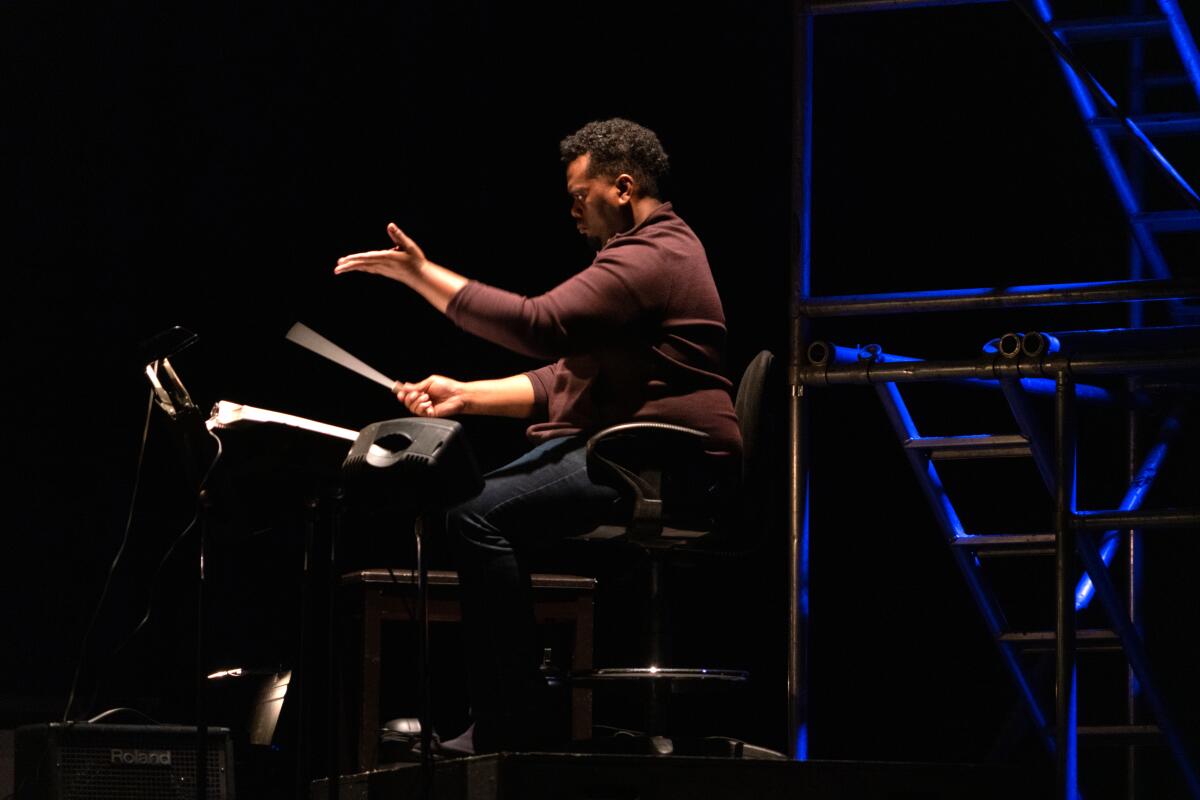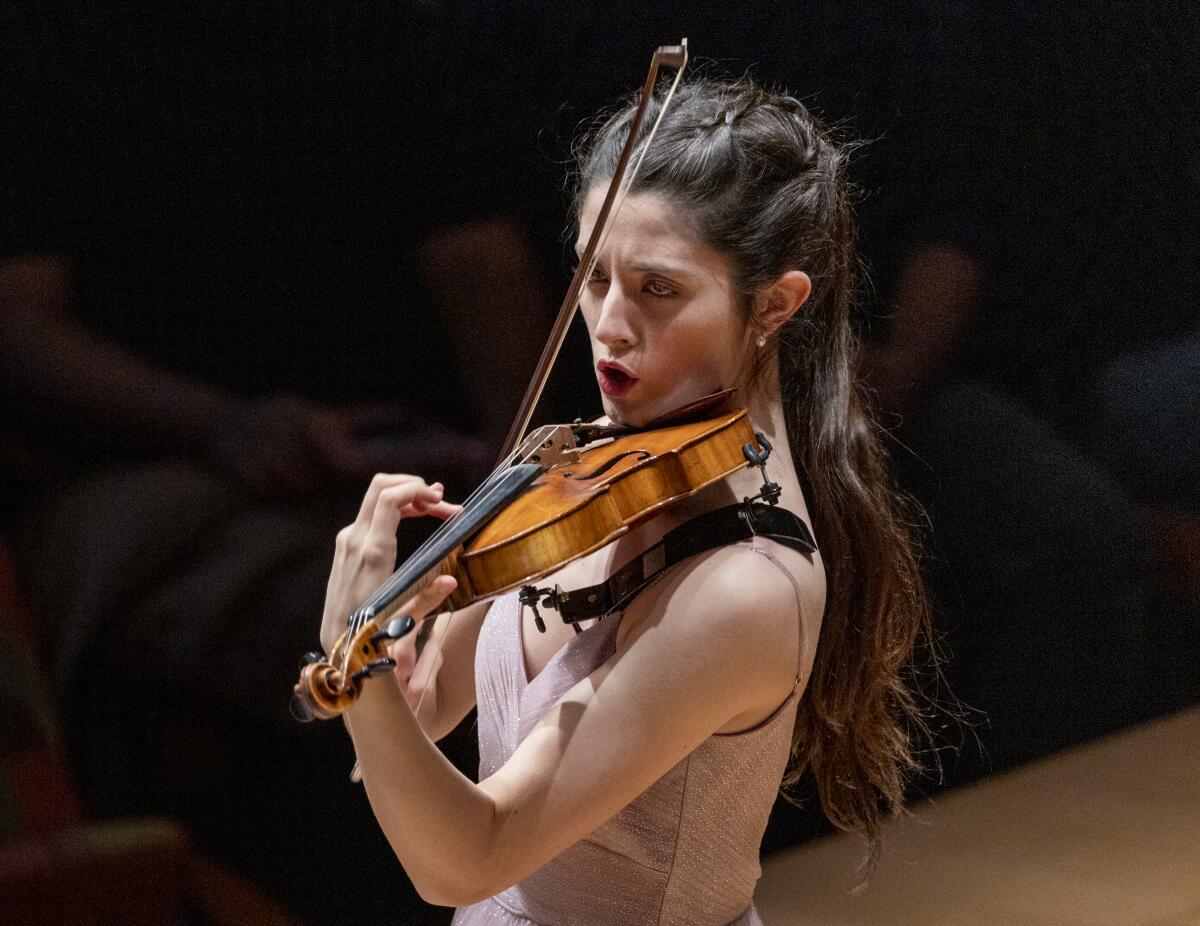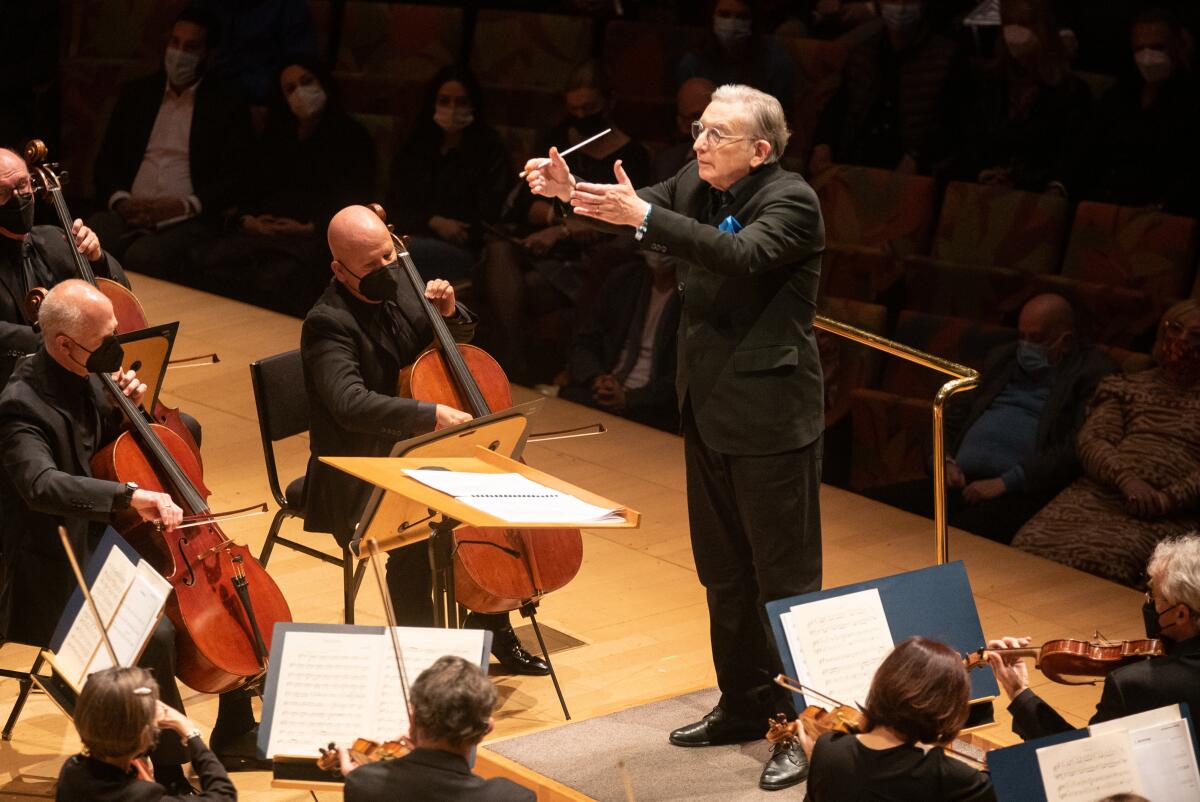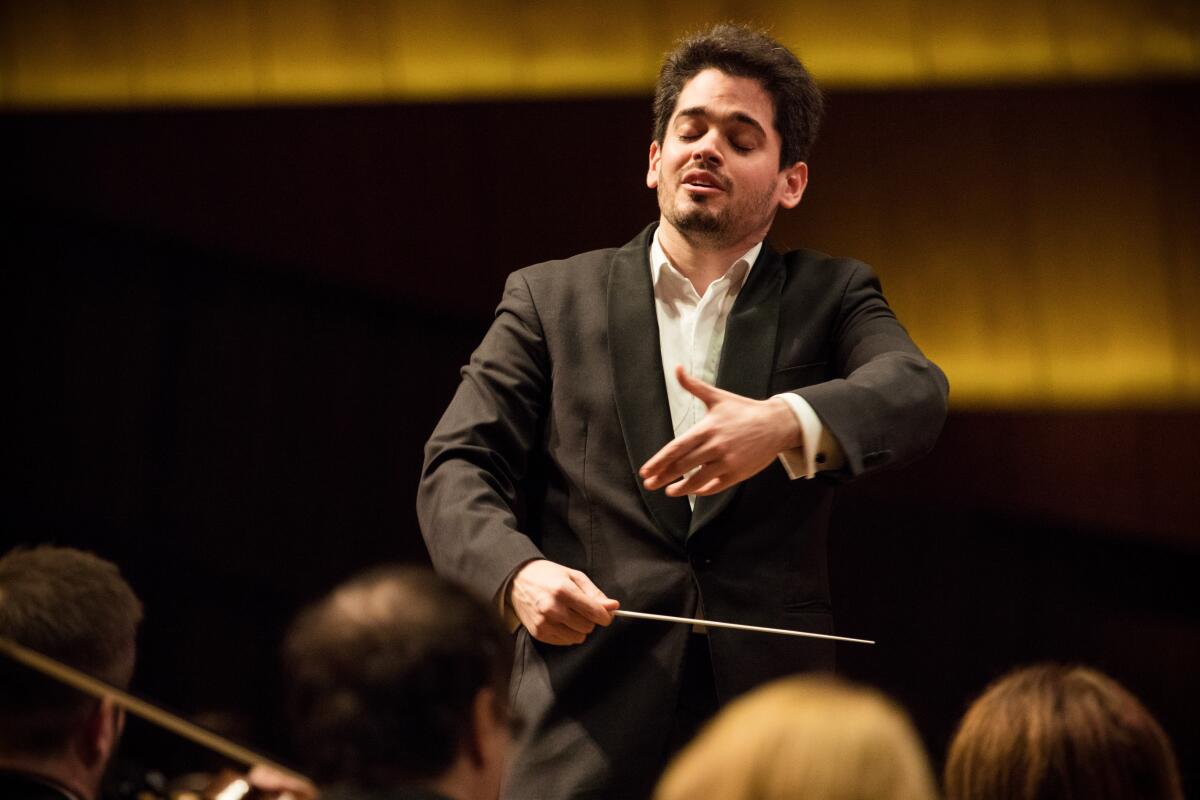The biggest entertainment stories
Get our big stories about Hollywood, film, television, music, arts, culture and more right in your inbox as soon as they publish.
You may occasionally receive promotional content from the Los Angeles Times.

Here we go again. Last year at this time, we looked back at our buoyancy, gingerly bouncing back from COVID-19. But 2022 became, with new surges, a boomerang year. Somehow, though, the performing arts are getting through it.
Many institutions, particularly new music groups, were not expected to survive, but Monday Evening Concerts, Brightwork newmusic and its Tuesdays @ Monk Space series, Wild Up and Jacaranda managed impressive and progressive seasons. The in-most-ways wonderful Wende Museum of the Cold War was the outlier, disappointingly dropping its fascinating new music programming.
Musicians, bereft of playing for live audiences during the pandemic, have soldiered on, and many thrived. Gustavo Dudamel has been a model. He’s been news every year since his Hollywood debut in 2005 and is easy to take for granted. But his accomplishments in a compromised 2022 require a whole column of their own.
You would never know that as music and artistic director of the Los Angeles Philharmonic, Dudamel headed an orchestra that lost about $100 million in projected revenue during the shutdown. He oversaw and compellingly conducted the L.A. Phil in two of the year’s most startlingly original opera productions anywhere: Beethoven’s “Fidelio” with Deaf West Theatre at Walt Disney Concert Hall and Yuval Sharon’s revolutionary sci-fi “Valkyries,” the third act of Wagner’s opera, with video wizardry at the Hollywood Bowl. Dudamel led monumental performances of Stravinsky ballets, paired with Latin American ballet scores. He won a Grammy for his L.A. Phil Ives symphony cycle and just got a nomination for his new L.A. Phil Dvorák symphony set. He was the subject of a major documentary, “¡Viva Maestro!”
Dudamel conducted a Schumann symphony cycle with the New York Philharmonic, leaving the locals certain he will be taking a bite of the Big Apple when Jaap van Zweden leaves in 2024. (We’ll see about that.) He so impressed in his first full year as music director of the Paris Opera that French President Emmanuel Macron made him an officer in the French Order of Arts and Letters. Connecting his two posts, Dudamel brought the Paris Opera Ballet to the Hollywood Bowl, making it one of the highlights of the amphitheater’s 100th-anniversary celebration. And, with his dance hat on, he conducted at Disney the first concert performance of Thomas Adès’ full-length ballet score “Dante,” which will almost certainly become a classic. Still to come will be Dudamel taking on the celebrated Bill Viola/Peter Sellars “Tristan Project” at Disney in December.
That’s not all, but it’s time to move on to some of the year’s other accomplishments.
For the record:
6:37 p.m. Dec. 5, 2022An earlier version of this article gave pianist Florence Price’s first name as Margaret.
In her first U.S. appearances with the Birmingham Symphony Orchestra, Mirga Gražinyte-Tyla demonstrated what a gifted and mesmerizing conductor of high artistic ideals looks like, sounds like and acts like. Meanwhile if you want to hear a real Berlin Philharmonic performance of Mahler’s Fifth Symphony rather than Cate Blanchett’s pretend version as the title character in the Todd Field’s film “Tár,” the orchestra happened to release a phenomenal live performance this year conducted by — him again — Dudamel.
Peter Sellars, in his transcendent “Music to Accompany a Departure,” a staging with the Los Angeles Master Chorale of Heinrich Schütz’s 1636 requiem Mass, the first written in German, required us to accompany the countless numbers who left us too early and too alone in the pandemic. For an incomparably moving, painstaking and tearful 70 minutes, we were invited (as if we had any option) to accept that the only way to be fully alive in this world is to know and experience what it means to leave it. Art that makes you sad yet grateful for every minute of life, as this “Departure” did, is art that rises highest.

We almost lost Long Beach Opera. A new administration and artistic director of the plucky company ran afoul of its attempts at diversity when newly appointed members of the team walked out over what they called a hostile environment. Two productions, including Karlheinz Stockhausen’s avant-garde choral piece “Stimmung,” may have been killed, but one fanciful production did get mounted: Handel’s “Giustino,” which proved a feast of imagination. A new production of Anthony Davis’ “The Central Park Five” was also lost, but the Pulitzer Prize-winning opera was given as a riveting concert performance so outstanding that it has been recorded.

The world premiere of Mark Morris’ “The Look of Love,” a wistful hour of lovingly choreographed dances to Burt Bacharach songs, had its world premiere at the Broad Stage in Santa Monica in October. The program included one of Bacharach’s earliest and silliest efforts — the theme song to the 1958 some-would-say-classic sci-fi film, “The Blob.” But pianist Ethan Iverson, who made the discerning jazz arrangements for Morris, threw in a fistful of tone clusters along with out-there harmonies in his version of “The Blob” that reminded us of the wonders of West Coast music. Bacharach studied with Henry Cowell, the father of West Coast music, inventor of tone clusters.
It’s been a good year for idiosyncratic sci-fi all around. The big deal at the L.A. Phil’s “Noon to Midnight” new music extravaganza was the premiere of Annie Gosfield’s riotous song cycle “The Secret Life of Planets,” written for a lounge singer (bass James Hayden) and flamboyant soprano (Hila Plitmann). They revealed our solar system as being made up of characters like a complacently fat and old Jupiter and a Venus besotted by Elvis’ bisexuality.

A star was born when María Dueñas made her U.S. debut with the L.A. Phil. No, she isn’t from another planet where they make teenage violinists with the poise, musical depth and effortless virtuosity of a young Heifetz. She’s just from Spain. With staggering maturity and insight, to say nothing of a glorious tone, she illuminated the world premiere of Gabriela Ortiz’s challenging Violin Concerto, “Altar de Cuerda,” which was written for her and is marvelously evocative of Mexican architecture.
Pregnancy compelled the compelling soprano Julia Bullock to cancel her appearances for the second half of the year. Even so, her presence was felt. She may have dropped out of John Adams’ “Antony and Cleopatra,” but she was its main muse. The San Francisco Opera premiere that opened the company’s centennial season in the fall received a mixed response without her, but everyone pretty much agreed that the orchestral score was great. Bullock also couldn’t appear in the L.A. Phil’s wide-ranging Rock My Soul Festival, which she curated. One highlight was a vibrant performance of Florence Price’s Third Symphony conducted by Jeri Lynne Johnson, who didn’t make it sound like warmed-over Dvorák.

Not the abbreviation of a breakthrough cancer drug, but the initials of Michael Tilson Thomas, who, having been treated for aggressive brain cancer the previous summer, spent 2022 conducting first in L.A., then around the U.S. and Europe. Berg’s Three Pieces for Orchestra requires epic cognitive ability from a conductor, and that’s exactly what MTT brought to it with the L.A. Phil in January. As of late fall, he was still going strong at the San Francisco Symphony and is once again scheduled to begin the new year with the L.A. Phil.

Let’s leave the Knesset out of this. Lahav Shani, the 33-year-old new music director of the Israel Philharmonic, visited the Soraya in Northridge just days after his homeland elected a nationalist far-right government certain to inflame Middle Eastern tensions. The concert opened with the revival of Paul Ben-Haim’s Symphony No. 1, which had its premiere by the orchestra in 1940, when Hitler’s legions were busy eliminating Jews all over Europe. The score reflected the tragedy of the times but in a language that combined elements of European tradition with sophisticated harmonic and melodic elements of Jewish music and that of Arabic music. It was a haunting reminder of the value of the multicultural nation-building that seems like sheer science fiction in the modern Middle East.
I’m not making this up, at least I don’t think I am. Frances Cole, a harpsichordist who was Black, made her well-received Carnegie Hall debut in 1971. She was a featured guest on “CBS Sunday Morning” and twice appeared on “Mister Rogers’ Neighborhood.” She died in 1983 at 45. She never made a solo recording and had been largely forgotten. But the record label Parnassus came across some amateur recordings made at live performances in 1974, cleaned them up and released them in the spring. Cole was brilliant. Her Bach, Scarlatti and Mozart are bold, vivid and rhythmically arresting. She made astonishing arrangements of Bartók in which the harpsichord mimics Hungarian folk instruments. Her performance of György Ligeti’s proto-minimalist 1968 “Continuum” rocks like no other. The CD is the find of the year.
The biggest entertainment stories
Get our big stories about Hollywood, film, television, music, arts, culture and more right in your inbox as soon as they publish.
You may occasionally receive promotional content from the Los Angeles Times.